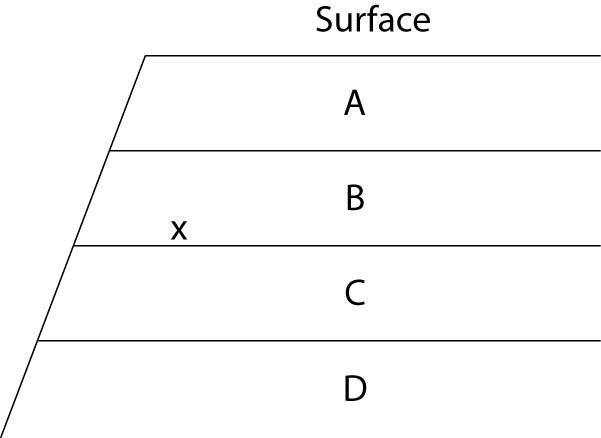
If x indicates the location of fossils of two closely related
species, then fossils of their most-recent common ancestor are most
likely to occur in which stratum?
A) A
B) B
C) C
D) D
C) C
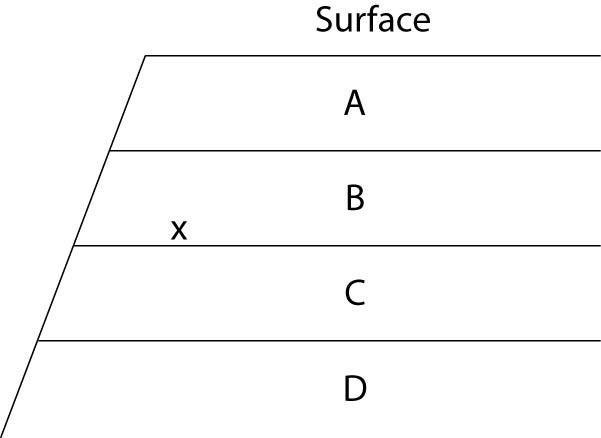
If x indicates the fossils of two closely related species, neither of
which is extinct, then their remains may be found in how many of these
strata?
A) one stratum
B) two strata
C) three strata
D) four strata
B) two strata
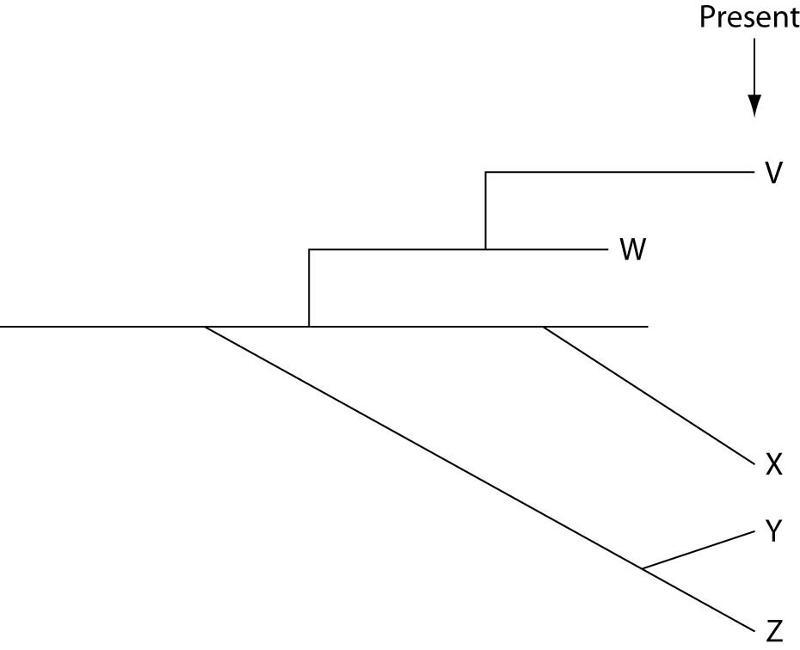
Which species is most closely related to species W?
A) V is
most closely related to species W.
B) X is most closely related
to species W.
C) Y and Z are equally closely related to W.
D) It is not possible to say from this tree.
A) V is most closely related to species W.
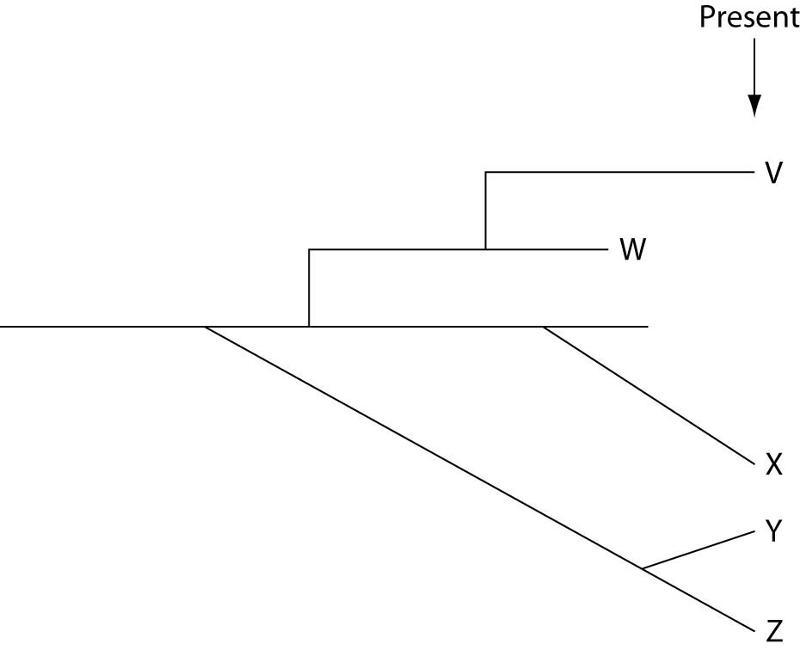
Which species is least expected to have a good record of transitional
fossils; in other words, which species' fossils, if present at all,
are expected only in relatively superficial (i.e., shallow) strata?
A) V
B) W
C) X
D) Y
E) Z
A) V
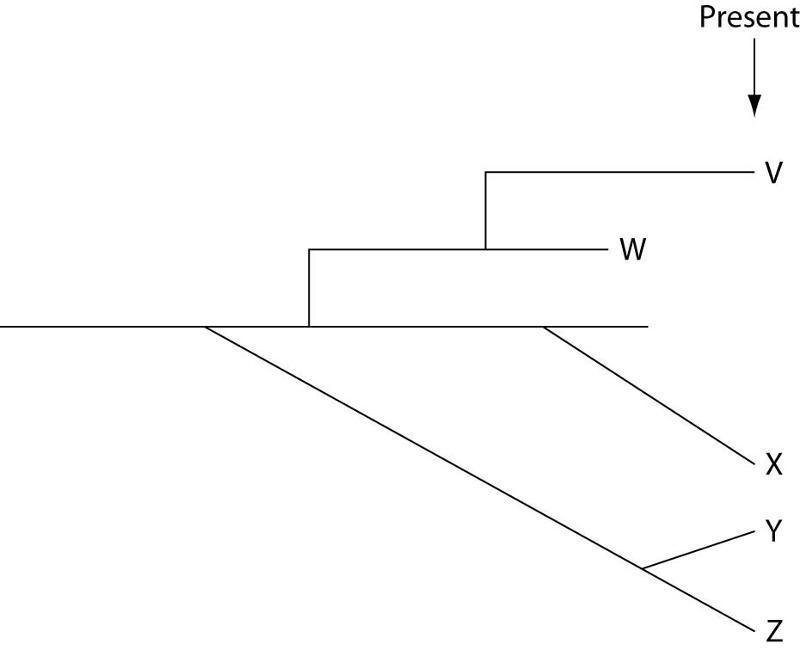
Which of these five species originated earliest and appeared suddenly
in the fossil record?
A) V
B) W
C) X
D) Y
E) Z
B) W
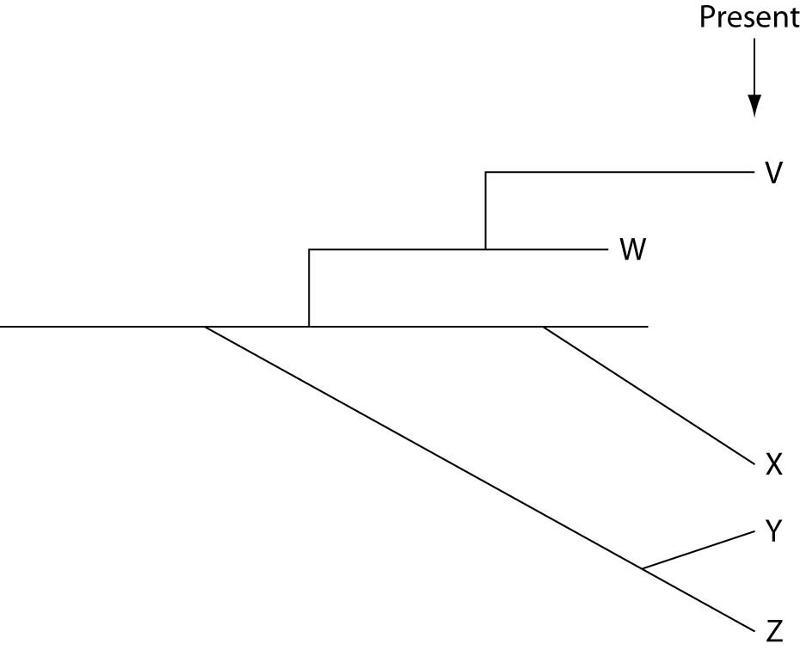
Which conclusion can be drawn from this evolutionary tree?
A)
Gradualistic speciation and speciation involving punctuated
equilibrium are mutually exclusive concepts; only one of them can
occur.
B) Eldredge and Gould would deny that the lineages
labeled X, Y, and Z could represent true species.
C) Assuming
that the tip of each line represents a species, there are five extant
(i.e., not extinct) species resulting from the earliest common
ancestor.
D) A single clade (i.e., a group of species that share
a common ancestor) can exhibit both gradualism and punctuated
equilibrium.
E) V and W shared a common ancestor more recently
than any of the other species.
D) A single clade (i.e., a group of species that share a common ancestor) can exhibit both gradualism and punctuated equilibrium.
Which of these five species is the extant (i.e., not extinct) species
that is most closely related to species X, and why is this so?
A) V; shared a common ancestor with X most recently
B) W;
shared a common ancestor with X most recently
C) Y; arose in the
same fashion (i.e., at the same tempo) as X
D) Z; shared a
common ancestor with X most recently, and arose in the same fashion as
X
E) This tree does not provide enough information to answer
this question.
A) V; shared a common ancestor with X most recently
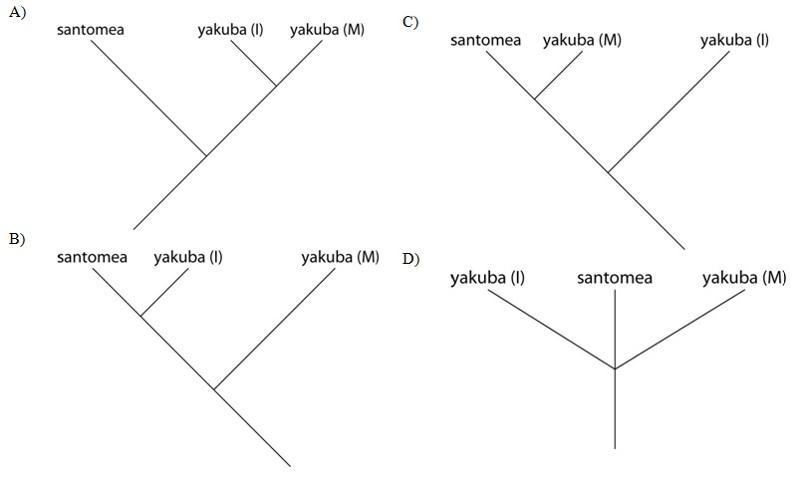
Which of these evolutionary trees represents the situation described
in the previous paragraph (Note: Yakuba (I) represents the island
population, and yakuba (M) represents the mainland population)?
A. SEE IMAGE
B. SEE IMAGE
C. SEE IMAGE
D. SEE IMAGE
A. SEE IMAGE
Which of the following pairs are the best examples of homologous
structures?
A) bones in the bat wing and bones in the human
forelimb
B) owl wing and hornet wing
C) bat wing and bird
wing
D) eyelessness in the Australian mole and eyelessness in
the North American mole
A) bones in the bat wing and bones in the human forelimb
Both ancestral birds and ancestral mammals shared a common ancestor
that was terrestrial. Today, penguins (which are birds) and seals
(which are mammals) have forelimbs adapted for swimming. What term
best describes the relationship of the bones in the forelimbs of
penguins and seals, and what term best describes the flippers of
penguins and seals?
A) homologous; homologous
B)
analogous; homologous
C) homologous; analogous
D)
analogous; analogous
C) homologous; analogous
Of the following anatomical structures, which is homologous to the
bones in the wing of a bird?
A) cartilage in the dorsal fin of a
shark
B) bones in the hind limb of a kangaroo
C) chitinous
struts in the wing of a butterfly
D) bony rays in the tail fin
of a flying fish
E) bones in the flipper of a whale
E) bones in the flipper of a whale
Which of these conditions should completely prevent the occurrence of
natural selection in a population over time?
A) All variation
between individuals is due only to environmental factors.
B) The
environment is changing at a relatively slow rate.
C) The
population size is large.
D) The population lives in a habitat
where there are no competing species present.
A) All variation between individuals is due only to environmental factors.
A trend toward the decrease in the size of plants on the slopes of
mountains as altitudes increase is an example of
A) a cline.
B) a bottleneck.
C) relative fitness.
D) genetic
drift.
E) geographic variation.
A) a cline.
Over time, the movement of people on Earth has steadily increased.
This has altered the course of human evolution by increasing
A)
nonrandom mating.
B) geographic isolation.
C) genetic
drift.
D) gene flow.
D) gene flow.
In a Hardy-Weinberg population with two alleles, A and a, that are in
equilibrium, the frequency of the allele a is 0.3. What is the
percentage of the population that is homozygous for this allele?
A) 0.09
B) 0.49
C) 0.9
D) 9.0
E) 49.0
D) 9.0
In a Hardy-Weinberg population with two alleles, A and a, that are in
equilibrium, the frequency of allele a is 0.2. What is the percentage
of the population that is heterozygous for this allele?
A) 0.2
B) 2.0
C) 4.0
D) 16.0
E) 32.0
E) 32.0
In a Hardy-Weinberg population with two alleles, A and a, that are in
equilibrium, the frequency of allele a is 0.1. What is the frequency
of individuals with AA genotype?
A) 0.20
B) 0.32
C)
0.42
D) 0.81
E) Genotype frequency cannot be determined
from the information provided.
D) 0.81
In peas, a gene controls flower color such that R = purple and r =
white. In an isolated pea patch, there are 36 purple-flowering plants
and 64 white-flowering plants. Assuming Hardy-Weinberg equilibrium,
what is the value of q for this population?
A) 0.36
B)
0.64
C) 0.75
D) 0.80
D) 0.80
In the year 2500, five male space colonists and five female space
colonists (all unrelated to each other) settle on an uninhabited
Earthlike planet in the Andromeda galaxy. The colonists and their
offspring randomly mate for generations. All ten of the original
colonists had free earlobes, and two were heterozygous for that trait.
The allele for free earlobes is dominant to the allele for attached
earlobes.
If one assumes that Hardy-Weinberg equilibrium
applies to the population of colonists on this planet, about how many
people will have attached earlobes when the planet's population
reaches 10,000?
A) 100
B) 400
C) 800
D) 1,000
E) 10,000
A) 100
A fruit fly population has a gene with two alleles, A1 and A2. Tests
show that 70% of the gametes produced in the population contain the A1
allele. If the population is in Hardy-Weinberg equilibrium, what
proportion of the flies carry both A1 and A2?
A) 0.7
B)
0.49
C) 0.21
D) 0.42
E) 0.09
D) 0.42
Sexual reproduction
A) allows animals to conserve resources and
reproduce only during optimal conditions.
B) can produce diverse
phenotypes that may enhance survival of a population in a changing
environment.
C) yields more numerous offspring more rapidly than
is possible with asexual reproduction.
D) enables males and
females to remain isolated from each other while rapidly colonizing
habitats.
E) guarantees that both parents will provide care for
each offspring.
B) can produce diverse phenotypes that may enhance survival of a population in a changing environment.
Which of the various species concepts distinguishes two species based
on the degree of genetic exchange between their gene pools?
A)
phylogenetic
B) ecological
C) biological
D) morphological
C) biological
There is still some controversy among biologists about whether
Neanderthals should be placed within the same species as modern humans
or into a separate species of their own. Most DNA sequence data
analyzed so far indicate that there was probably little or no gene
flow between Neanderthals and Homo sapiens. Which species concept is
most applicable in this example?
A) phylogenetic
B)
ecological
C) morphological
D) biological
D) biological
You are confronted with a box of preserved grasshoppers of various
species that are new to science and have not been described. Your
assignment is to separate them into species. There is no accompanying
information as to where or when they were collected. Which species
concept will you have to use?
A) biological
B)
phylogenetic
C) ecological
D) morphological
D) morphological
Dogs (Canis lupus familiaris) and gray wolves (Canis lupus) can
interbreed to produce viable, fertile offspring. These species shared
a common ancestor recently (in geologic time) and have a high degree
of genetic similarity, although their anatomies vary widely. Judging
from this evidence, which two species concepts are most likely to
place dogs and wolves together into a single species?
A)
ecological and morphological
B) ecological and phylogenetic
C) morphological and phylogenetic
D) biological and
morphological
E) biological and phylogenetic
E) biological and phylogenetic
Which of the following factors weaken(s) the hypothesis of abiotic
synthesis of organic monomers in early Earth's atmosphere?
1. the relatively short time between intense meteor bombardment
and the appearance of the first life-forms
2. the lack of
experimental evidence that organic monomers can form by abiotic
synthesis
3. uncertainty about which gases comprised early
Earth's atmosphere
A) 1 only
B) 2 only
C) 1
and 2
D) 1 and 3
E) 2 and 3
D) 1 (the relatively short time between intense meteor bombardment and the appearance of the first life-forms) and 3 (uncertainty about which gases comprised early Earth's atmosphere)
Traditionally, zoologists have placed birds in their own class, Aves.
More recently, molecular evidence has shown that birds are more
closely related to reptiles than their anatomy reveals. Genetically,
birds are more closely related to crocodiles than crocodiles are to
turtles. Thus, bird anatomy has become highly modified as they have
adapted to flight, without their genes having undergone nearly as much
change.
Taxonomically, what should be done with the
birds?
A) The traditional stance is correct. Such dramatic
morphological change as undergone by birds merits that the birds be
placed in their own order, separate from the reptiles.
B) The
birds should be reclassified, and their new taxon should be the
subclass Aves. Genetic similarity trumps morphological dissimilarity.
C) The rest of the reptiles should be reclassified as a
subclass within the class Aves.
D) Science is consensual.
Taxonomy is a science. Variant classification schemes involving the
birds should be tolerated until consensus is reached.
D) Science is consensual. Taxonomy is a science. Variant classification schemes involving the birds should be tolerated until consensus is reached.
Linnaeus was a "fixist" who believed that species remained
fixed in the form in which they had been created. Linnaeus would have
been uncomfortable with
A) classifying organisms using the
morphospecies concept.
B) the scientific discipline known as
taxonomy.
C) phylogenies.
D) nested, ever-more inclusive
categories of organisms.
E) a hierarchical classification scheme.
C) phylogenies.
The various taxonomic levels (namely, genera, classes, etc.) of the
hierarchical classification system differ from each other on the basis
of
A) how widely the organisms assigned to each are distributed
throughout the environment.
B) their inclusiveness.
C) the
relative genome sizes of the organisms assigned to each.
D)
morphological characters that are applicable to all organisms.
B) their inclusiveness.
In the traditional phylogeny (A), the phylum Platyhelminthes is
depicted as a sister taxon to the rest of the protostome phyla, and as
having diverged earlier from the lineage that led to the rest of the
protostomes. In the molecular phylogeny (B), Platyhelminthes is
depicted as a lophotrochozoan phylum. What probably led to this
change?
A) Platyhelminthes ceased to be recognized as true
protostomes.
B) The removal of the acoel flatworms (Acoela) from
the Platyhelminthes allowed the remaining flatworms to be clearly tied
to the Lophotrochozoa.
C) All Platyhelminthes must have a
well-developed lophophore as their feeding apparatus.
D)
Platyhelminthes' close genetic ties to the arthropods became clear as
their Hox gene sequences were studied.
B) The removal of the acoel flatworms (Acoela) from the Platyhelminthes allowed the remaining flatworms to be clearly tied to the Lophotrochozoa.
Match the numbered terms to the description that follows. Choose all
appropriate terms.
1. autotroph
2. heterotroph
3.
phototroph
4. chemotroph
a prokaryote that obtains
both energy and carbon as it decomposes dead organisms &
an organism that obtains both carbon and energy by ingesting
prey
A) 1 only
B) 4 only
C) 1 and 3
D) 2 and
4
E) 1, 3, and 4
D) 2 (heterotroph) and 4 (chemotroph)
Match the numbered terms to the description that follows. Choose all
appropriate terms.
1. autotroph
2. heterotroph
3.
phototroph
4. chemotroph
an organism that relies on
photons to excite electrons within its membranes
A) 1 only
B) 3 only
C) 1 and 3
D) 2 and 4
E) 1, 3, and 4
B) 3 only (phototroph)
Which measurement(s) would help determine absolute dates by
radiometric means?
A) the accumulation of the daughter isotope
B) the loss of parent isotopes
C) the loss of daughter
isotopes
D) Three of the responses above are correct.
E)
Two of the responses above are correct.
E) Two of the responses above are correct.
A) the accumulation of the daughter isotope
B)
the loss of parent isotopes
If a fossil is encased in a stratum of sedimentary rock without any
strata of igneous rock (for example, lava, volcanic ash) nearby, then
it should be
A) easy to determine the absolute age of the
fossil, because the radioisotopes in the sediments will not have been
"reset" by the heat of the igneous rocks.
B) easy to
determine the absolute age of the fossil, because the igneous rocks
will not have physically obstructed the deposition of sediment of a
single age next to the fossil.
C) easy to determine, as long as
there is enough metamorphic rock nearby.
D) difficult to
determine the absolute age of the fossil, because the "marker
fossils" common to igneous rock will be absent.
E)
difficult to determine the absolute age of the fossil, because
radiometric dating of sedimentary rock is less accurate than that of
igneous rock.
E) difficult to determine the absolute age of the fossil, because radiometric dating of sedimentary rock is less accurate than that of igneous rock.
The ancestors of land plants were aquatic algae. Which of the
following is not an evolutionary adaptation to life on land?
A)
C₃ photosynthesis
B) a waxy cuticle
C) root hairs
D)
xylem and phloem
E) guard cells
A) C₃ photosynthesis
Which of the following would be least likely to affect osmosis in
plants?
A) proton pumps in the membrane
B) a difference in
solute concentrations
C) receptor proteins in the membrane
D) aquaporins
E) a difference in water potential
C) receptor proteins in the membrane
Active transport of various materials in plants at the cellular level
requires all of the following except
A) a proton gradient.
B) ATP.
C) membrane potential.
D) transport proteins
E) xylem membranes.
E) xylem membranes.
Given that early land plants most likely share a common ancestor with
green algae, the earliest land plants were most likely
A)
nonvascular plants that grew leafless photosynthetic shoots above the
shallow fresh water in which they lived.
B) species that did not
exhibit alternation of generations.
C) vascular plants with
well-defined root systems.
D) plants with well-developed leaves.
E) species with a well-developed, thick cuticle.
A) nonvascular plants that grew leafless photosynthetic shoots above the shallow fresh water in which they lived.
Transpiration in plants requires all of the following except
A)
adhesion of water molecules to cellulose.
B) cohesion between
water molecules.
C) evaporation of water molecules.
D)
active transport through xylem cells.
E) transport through tracheids.
D) active transport through xylem cells.
Which of the following statements about transport in plants is false?
A) Weak bonding between water molecules and the walls of xylem
vessels or tracheids helps support the columns of water in the xylem.
B) Hydrogen bonding between water molecules, which results in
the high cohesion of the water, is essential for the rise of water in
tall trees.
C) Although some angiosperm plants develop
considerable root pressure, this is not sufficient to raise water to
the tops of tall trees.
D) Most plant physiologists now agree
that the pull from the top of the plant resulting from transpiration
is sufficient, when combined with the cohesion of water, to explain
the rise of water in the xylem in even the tallest trees.
E)
Gymnosperms can sometimes develop especially high root pressure, which
may account for the rise of water in tall pine trees without
transpiration pull.
E) Gymnosperms can sometimes develop especially high root pressure, which may account for the rise of water in tall pine trees without transpiration pull.
Plants do not have a circulatory system like that of some animals. If
a water molecule did "circulate" (that is, go from one point
in a plant to another and back in the same day), it would require the
activity of
A) only the xylem.
B) only the phloem.
C) only the endodermis.
D) both the xylem and the
endodermis.
E) both the xylem and the phloem.
E) both the xylem and the phloem.
At the conclusion of meiosis in plants, the end products are always
four haploid
A) spores.
B) eggs.
C) sperm.
D)
seeds.
E) gametes.
A) spores.
Which of the following is true in plants?
A) Mitosis occurs in
gametophytes to produce gametes.
B) Meiosis occurs in
sporophytes to produce spores.
C) The gametophyte is within the
flower in angiosperms.
D) Mitosis occurs in gametophytes to
produce gametes, and meiosis occurs in sporophytes to produce spores.
E) Mitosis occurs in gametophytes to produce gametes, meiosis
occurs in sporophytes to produce spores, and the gametophyte is within
the flower in angiosperms.
E) Mitosis occurs in gametophytes to produce gametes, meiosis occurs in sporophytes to produce spores, and the gametophyte is within the flower in angiosperms.
Microsporangia in flowering plants are located in the
A)
stamen.
B) carpel.
C) petals.
D) sepals.
E) receptacle.
A) stamen.
Which of the following statements regarding flowering plants is
false?
A) The sporophyte is the dominant generation.
B)
Female gametophytes develop from megaspores within the anthers.
C) Pollination is the placing of pollen on the stigma of a
carpel.
D) The food-storing endosperm is derived from the cell
that contains two polar nuclei and one sperm nucleus.
E) Flowers
produce fruits within the ovules.
B) Female gametophytes develop from megaspores within the anthers.
Where and by which process are sperm cells formed in plants?
A)
meiosis in pollen grains
B) meiosis in anthers
C) mitosis
in male gametophyte pollen tube
D) mitosis in the micropyle
E) mitosis in the embryo sac
C) mitosis in male gametophyte pollen tube
What is the difference between pollination and fertilization in
flowering plants?
A) Fertilization precedes pollination.
B) Pollination easily occurs between plants of different
species, whereas fertilization is within a species.
C) Pollen is
formed within megasporangia so that male and female gametes are near
each other.
D) Pollination is the transfer of pollen from an
anther to a stigma. Fertilization is the fusion of haploid nuclei.
E) If fertilization occurs, pollination is unnecessary.
D) Pollination is the transfer of pollen from an anther to a stigma. Fertilization is the fusion of haploid nuclei.
The functional significance of porous septa in certain fungal hyphae
is most similar to that represented by which pair of structures in
animal cells and plant cells, respectively?
A)
desmosomestonoplasts
B) gap junctionsplasmodesmata
C)
tight junctionsplastids
D) centriolesplastids
E)
flagellacentral vacuoles
B) gap junctionsplasmodesmata
In septate fungi, what structures allow cytoplasmic streaming to
distribute needed nutrients, synthesized compounds, and organelles
throughout the hyphae?
A) multiple chitinous layers in
cross-walls
B) pores in cross-walls
C) complex
microtubular cytoskeletons
D) two nuclei
E) tight
junctions that form in cross-walls between cells
B) pores in cross-walls
Which of these paired fungal structures are structurally and
functionally most alike?
A) conidia and basidiocarps
B)
sporangia and hyphae
C) soredia and gills
D) haustoria and
arbuscules
E) zoospores and mycelia
D) haustoria and arbuscules
you are given an organism to identify. It has a fruiting body that
contains many structures with eight haploid spores lined up in a row.
What kind of a fungus is this?
A) zygomycete
B) ascomycete
C) deuteromycete
D) chytrid
E) basidiomycete
B) ascomycete
Which of the following cells or structures are associated with
asexual reproduction in fungi?
A) ascospores
B)
basidiospores
C) zygosporangia
D) conidiophores
E) ascocarps
D) conidiophores
Which of the following has the least affiliation with all of the
others?
A) Glomeromycota
B) mycorrhizae
C) lichens
D) arbuscules
E) mutualistic fungi
C) lichens
Lichens are symbiotic associations of fungi and
A) mosses.
B) cyanobacteria.
C) green algae.
D) Three of these
responses are correct.
E) Two of these responses are correct.
B) cyanobacteria & C) green algae.
In both lichens and mycorrhizae, what does the fungal partner provide
to its photosynthetic partner?
A) carbohydrates
B) fixed
nitrogen
C) antibiotics
D) water and minerals
E)
protection from harmful UV
D) water and minerals
Which of the following best describes the physical relationship of
the partners involved in lichens?
A) Fungal cells are enclosed
within algal cells.
B) Lichen cells are enclosed within fungal
cells.
C) Photosynthetic cells are surrounded by fungal hyphae.
D) The fungi grow on rocks and trees and are covered by algae.
E) Algal cells and fungal cells mix together without any
apparent structure.
C) Photosynthetic cells are surrounded by fungal hyphae.
If haustoria from the fungal partner were to appear within the
photosynthetic partner of a lichen, and if the growth rate of the
photosynthetic partner consequently slowed substantially, then this
would support the claim that
A) algae and cyanobacteria are
autotrophic.
B) lichens are not purely mutualistic
relationships.
C) algae require maximal contact with the fungal
partner in order to grow at optimal rates.
D) fungi get all of
the nutrition they need via the "leakiness" of
photosynthetic partners.
E) soredia are asexual reproductive
structures combining both the fungal and photosynthetic partners.
B) lichens are not purely mutualistic relationships
The photosynthetic symbiont of a lichen is often
A) a moss.
B) a green alga.
C) a brown alga.
D) an ascomycete.
E) a small vascular plant.
B) a green alga.
A radula is present in members of which clade(s)?
A) chitons
B) bivalves
C) gastropods
D) cephalopods
E)
both chitons and gastropods
E) both chitons and gastropods
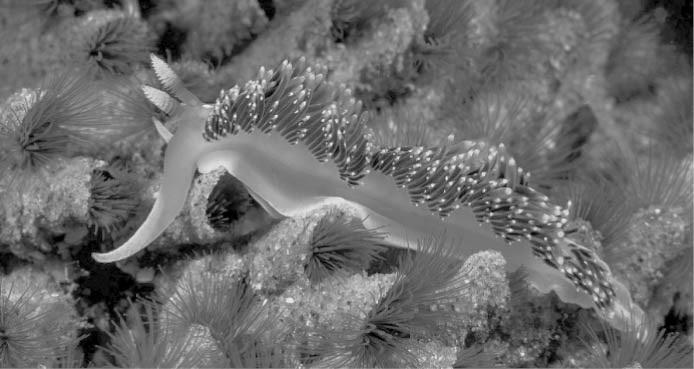
This nudibranch, a type of sea slug, has many reddish cerata on its
dorsal surface, as well as two, white-tipped rhinophores located on
the head.
SEE IMAGE
The nontaxonomic term
sea slug encompasses a wide variety of marine gastropods. One feature
they share as adults is the lack of a shell. We might think,
therefore, that they represent defenseless morsels for predators. In
fact, sea slugs have multiple defenses. Some sea slugs prey on
sponges and concentrate sponge toxins in their tissues. Others feed
on cnidarians, digesting everything except the nematocysts, which
they then transfer to their own skins. Whereas the most brightly
colored sea slugs are often highly toxic, others are nontoxic and
mimic the coloration of the toxic species. Their colors are mostly
derived from pigments in their prey. There are also sea slugs that
use their coloration to blend into their environments.
49) Which structure do sea slugs use to feed on their prey?
A) nematocysts
B) a sharp beak
C) an incurrent
siphon
D) a radula
E) a mantle cavity
D) a radula
With which of the following statements would a biologist be most
inclined to agree?
A) Humans and apes represent divergent lines
of evolution from a common ancestor.
B) Humans evolved directly
from Old World monkeys.
C) Humans represent the pinnacle of
evolution and have escaped from being affected by natural selection.
D) Humans evolved from chimpanzees.
E) Humans and apes are
the result of disruptive selection in a species of chimpanzee.
A) Humans and apes represent divergent lines of evolution from a common ancestor.
Which of the following statements about human evolution is correct?
A) Modern humans are the only human species to have evolved on
Earth.
B) Human ancestors were virtually identical to extant
chimpanzees.
C) Human evolution has occurred within an
unbranched lineage.
D) The upright posture and enlarged brain of
humans evolved simultaneously.
E) Fossil evidence indicates that
early anthropoids were arboreal and cat-sized.
E) Fossil evidence indicates that early anthropoids were arboreal and cat-sized.
Tissues are composed of cells, and tissues functioning together make
up
A) organs.
B) membranes.
C) organ systems.
D) organelles.
E) organisms.
A) organs.
Connective tissues typically have
A) many densely packed cells
with direct connections between the membranes of adjacent cells.
B) a supporting material such as chondroitin sulfate.
C)
the ability to shorten upon stimulation.
D) relatively few cells
and a large amount of extracellular matrix.
E) the ability to
transmit electrochemical impulses.
D) relatively few cells and a large amount of extracellular matrix.
A general rule relating the capacity of a specific animal's digestive
system to provide adequate access to substrates for biosynthesis of
cellular components, as well as fuel molecules needed for ATP
production, is that the animal should have access to
A) a
high-protein, low-carbohydrate diet.
B) a diet low in lipids and
high in protein.
C) a low-calorie diet with a large intake of
fluids, especially water.
D) a diet that matches the "food
pyramid" for the species.
E) a diet that maximizes vitamins
and minerals.
D) a diet that matches the "food pyramid" for the species.
An advantage of a complete digestive system over a gastrovascular
cavity is that the complete system
A) excludes the need for
extracellular digestion.
B) allows specialized functions in
specialized regions.
C) allows digestive enzymes to be more
specific.
D) allows extensive branching.
E) facilitates
intracellular digestion
B) allows specialized functions in specialized regions
In the digestive system, peristalsis is
A) a process of fat
emulsification in the small intestine.
B) voluntary control of
the rectal sphincters regulating defecation.
C) the transport of
nutrients to the liver through the hepatic portal vessel.
D) a
common cause of loss of appetite, fatigue, and dehydration.
E)
smooth muscle contractions that move food along the esophagus.
E) smooth muscle contractions that move food along the esophagus.
Which of the following organs is incorrectly paired with its
function?
A) stomachprotein digestion
B) oral
cavitystarch digestion
C) large intestinebile production
D) small intestinenutrient absorption
E) pancreasenzyme production
C) large intestinebile production
The molar teeth of herbivorous mammals are especially effective at
A) cutting.
B) ripping.
C) grinding.
D)
splitting.
E) piercing.
C) grinding.
Which of the following animals is incorrectly paired with its feeding
mechanism?
A) lionsubstrate feeder
B) baleen
whalesuspension feeder
C) aphidfluid feeder
D)
clamsuspension feeder
E) snakebulk feeder
A) lionsubstrate feeder
Which of the following pairs of mammalian blood vessels has blood
that is the least similar in its gas content?
A) the pulmonary
vein and the jugular vein
B) the veins from the right and left
legs
C) the pulmonary artery and the vena cava
D) the
pulmonary vein and the aorta
E) the inferior vena cava and the
superior vena cava
A) the pulmonary vein and the jugular vein
The set of blood vessels with the slowest velocity of blood flow is
A) the arteries.
B) the arterioles.
C) the
metarterioles.
D) the capillaries.
E) the veins.
D) the capillaries.
The set of blood vessels with the lowest blood pressure driving flow
is
A) the arteries.
B) the arterioles.
C) the
metarterioles.
D) the capillaries.
E) the veins.
E) the veins.
Histamines trigger dilation of nearby blood vessels as well as an
increase in their permeability, producing
A) redness and heat
only.
B) swelling only.
C) pain.
D) redness, heat,
and swelling.
E) all of the signs of a major infection.
D) redness, heat, and swelling.
Which nitrogenous waste has the greatest number of nitrogen atoms?
A) ammonia
B) ammonium ions
C) urea
D) uric acid
D) uric acid
Excessive formation of uric acid crystals in humans leads to
A)
a condition called diabetes, where excessive urine formation occurs.
B) a condition of insatiable thirst and excessive urine
formation.
C) gout, a painful inflammatory disease that
primarily affects the joints.
D) the absence of urea in the
urine.
E) osteoarthritis, an inevitable consequence of aging.
C) gout, a painful inflammatory disease that primarily affects the joints.
The primary nitrogenous waste excreted by birds is
A) ammonia.
B) nitrate.
C) nitrite.
D) urea.
E) uric acid.
E) uric acid.
Birds secrete uric acid as their nitrogenous waste because uric acid
A) is readily soluble in water.
B) is metabolically less
expensive to synthesize than other excretory products.
C)
requires little water for nitrogenous waste disposal, thus reducing
body mass.
D) excretion allows birds to live in desert environments.
C) requires little water for nitrogenous waste disposal, thus reducing body mass
Which of the following pairs of organisms excrete nitrogenous wastes
in the form of uric acid?
A) mice and birds
B) insects and
birds
C) lions and horses
D) humans and frogs
E)
fish and turtles
B) insects and birds
A person with alkalosis will likely excrete urine that has abnormally
high levels of
A) bicarbonate ions.
B) sodium ions.
C) glucose.
D) ammonia.
E) NaOH.
B) sodium ions.
Human urine is usually more acidic than most other body fluids
because
A) hydrogen ions are actively moved into the filtrate.
B) the sodium transporter exchanges one hydrogen ion for each
sodium ion.
C) excreted plasma proteins are nearly all acidic
ions.
D) excreted amino acids are in abundance.
E)
potassium and sodium exchange generates lots of acidity
A) hydrogen ions are actively moved into the filtrate.
If ATP production in a human kidney was suddenly halted, urine
production would
A) come to a complete halt.
B) decrease,
and the urine would be hypoosmotic compared to plasma.
C)
increase, and the urine would be isoosmotic compared to plasma.
D) increase, and the urine would be hyperosmotic compared to
plasma.
E) decrease, and the urine would be isoosmotic compared
to plasma.
C) increase, and the urine would be isoosmotic compared to plasma.
Juxtamedullary nephrons can concentrate salt effectively in the renal
medulla because of their long
A) loops of Henle.
B) distal
convoluted tubules.
C) Bowman's capsules.
D) proximal
convoluted tubules.
E) glomeruli.
A) loops of Henle.
Unlike an earthworm's metanephridia, a mammalian nephron
A) is
intimately associated with a capillary network.
B) forms urine
by changing fluid composition inside a tubule.
C) functions in
both osmoregulation and excretion.
D) receives filtrate from
blood instead of coelomic fluid.
E) has a transport epithelium.
D) receives filtrate from blood instead of coelomic fluid.
Which process in the nephron is least selective?
A) filtration
B) reabsorption
C) active transport
D) secretion
E) salt pumping by the loop of Henle
A) filtration
When female fruit flies mate with two different males on the same
day,
A) the first male's sperm fertilizes all of the eggs.
B) the first male's sperm fertilizes most of the eggs.
C)
the second male's sperm fertilizes most of the eggs.
D) the
first and second males fertilize equal numbers of eggs.
E) none
of the eggs become fertilized.
C) the second male's sperm fertilizes most of the eggs.
In male mammals, excretory and reproductive systems share
A)
the testes.
B) the urethra.
C) the seminal vesicle.
D) the vas deferens.
E) the prostate.
B) the urethra.
Animals with reproduction dependent on internal fertilization need
not have
A) any copulatory organs.
B) a receptacle that
receives sperm.
C) behavioral interaction between males and
females.
D) internal development of embryos.
E) haploid gametes.
D) internal development of embryos.
In close comparisons, external fertilization often yields more
offspring than does internal fertilization. However, internal
fertilization offers the advantage that
A) it is the only way to
ensure the survival of the species.
B) it requires less time and
energy to be devoted to reproduction.
C) the smaller number of
offspring produced often receive a greater amount of parental
investment.
D) it permits the most rapid population increase.
E) it requires expression of fewer genes and maximizes genetic stability.
C) the smaller number of offspring produced often receive a greater amount of parental investment.
Internal and external fertilization both
Internal and external
fertilization both
A) produce single-celled zygotes.
B)
occur only among invertebrates.
C) occur only among terrestrial
animals.
D) depend on the use of intromittent copulatory organs.
E) occur only among birds.
B) occur only among
invertebrates.
C) occur only among terrestrial animals.
D)
depend on the use of intromittent copulatory organs.
E) occur
only among birds.
A) produce single-celled zygotes.
Most flatworms, including parasitic liver flukes, are hermaphrodites
that form zygotes as the result of
A) internal fertilization.
B) external fertilization.
C) parthenogenesis.
D)
eggs and sperm mixing together in excreted feces.
E) eggs and
sperm mixing together in wastewater.
A) internal fertilization.
At the time of fertilization, the complete maturation of each
oogonium has resulted in
A) one secondary oocyte.
B) two
primary oocytes.
C) four secondary oocytes.
D) four
primary oocytes.
E) four zygotes.
A) one secondary oocyte.
Fertilization of human eggs usually takes place in the
A)
ovary.
B) uterus.
C) vagina.
D) oviduct.
E) cervix.
D) oviduct.
Two contraceptive methods that are generally irreversible and which
block the gametes from moving to a site where fertilization can occur
are
A) the male condom and female condom.
B) the male
condom and oral contraceptives.
C) vasectomy and tubal ligation.
D) coitus interruptus and rhythm method.
E) the diaphragm
and subcutaneous progesterone implant.
C) vasectomy and tubal ligation.
As an embryo develops, new cells are produced as the result of
A) differentiation.
B) preformation.
C) cell
division.
D) morphogenesis.
E) epigenesis.
C) cell division.
From earliest to latest, the overall sequence of early development
proceeds in which of the following sequences?
A) first cell
division → synthesis of embryo's DNA begins → acrosomal reaction →
cortical reaction
B) cortical reaction → synthesis of embryo's
DNA begins → acrosomal reaction → first cell division
C)
cortical reaction → acrosomal reaction → first cell division →
synthesis of embryo's DNA begins
D) first cell division →
synthesis of embryo's DNA begins → acrosomal reaction → cortical
reaction
E) acrosomal reaction → cortical reaction → synthesis
of embryo's DNA begins → first cell division
E) acrosomal reaction → cortical reaction → synthesis of embryo's DNA begins → first cell division
The pattern of embryonic development in which only the cells lacking
yolk subsequently undergo cleavage is called
A) arcadian
development, which is typical of insects.
B) holoblastic
development, which is typical of marsupial mammals.
C)
meroblastic development, which is typical of humans.
D)
holoblastic development, which is typical of amphibians.
E)
meroblastic development, which is typical of birds.
E) meroblastic development, which is typical of birds.
A primitive streak forms during the early embryonic development of
A) birds, but not frogs or humans.
B) frogs, but not birds
or humans.
C) humans, but not birds or frogs.
D) birds and
frogs, but not humans.
E) humans and birds, but not frogs.
E) humans and birds, but not frogs.
If gastrulation was blocked by an environmental toxin, then
A)
cleavage would not occur in the zygote.
B) embryonic germ layers
would not form.
C) fertilization would be blocked.
D) the
blastula would not be formed.
E) the blastopore would form above
the gray crescent in the animal pole.
B) embryonic germ layers would not form.
The nucleus and most of the organelles in a neuron are located in the
A) dendritic region.
B) axon hillock.
C) axon.
D) cell body.
E) axon terminals.
D) cell body.
The point of connection between two communicating neurons is called
A) the axon hillock.
B) the dendrite.
C) the
synapse.
D) the cell body.
E) the glia.
C) the synapse.
In a simple synapse, neurotransmitter chemicals are released by
A) the dendritic membrane.
B) the presynaptic membrane.
C) axon hillocks.
D) cell bodies.
E) ducts on the
smooth endoplasmic reticulum.
B) the presynaptic membrane.
In a simple synapse, neurotransmitter chemicals are received by
A) the dendritic membrane.
B) the presynaptic membrane.
C) axon hillocks.
D) cell bodies.
E) ducts on the
smooth endoplasmic reticulum
A) the dendritic membrane.
Neurotransmitters are released from axon terminals via
A)
osmosis.
B) active transport.
C) diffusion.
D)
transcytosis.
E) exocytosis.
E) exocytosis.
Neurotransmitters categorized as inhibitory are expected to
A)
act independently of their receptor proteins.
B) close potassium
channels.
C) open sodium channels.
D) close chloride
channels.
E) hyperpolarize the membrane.
E) hyperpolarize the membrane.
Receptors for neurotransmitters are of primary functional importance
in assuring one-way synaptic transmission because they are mostly
found on the
A) axonal membrane.
B) axon hillock.
C)
dendritic membrane.
D) mitochondrial membrane.
E)
presynaptic membrane.
C) dendritic membrane.
The primary neurotransmitter from the parasympathetic system that
influences its autonomic targets is
A) acetylcholine.
B)
adenosine.
C) norepinephrine.
D) adrenaline.
E) dopamine.
A) acetylcholine.
The major inhibitory neurotransmitter of the human
brain is
A) acetylcholine.
B) epinephrine.
C)
glutamate.
D) nitric oxide.
E) GABA.
E) GABA.
The major excitatory neurotransmitter of the human
brain is
A) acetylcholine.
B) epinephrine.
C)
glutamate.
D) nitric oxide.
E) GABA.
D) nitric oxide.
Where are neurotransmitter receptors located?
A) the nuclear
membrane
B) the nodes of Ranvier
C) the postsynaptic
membrane
D) synaptic vesicle membranes
E) the myelin sheath
C) the postsynaptic membrane
Select the choice that correctly associates the organ with its
embryonic sources.
A) anterior pituitary glandmesoderm and
endoderm
B) thyroid glandmesoderm and ectoderm
C) adrenal
glandectoderm and mesoderm
D) skinendoderm and mesoderm
E) brainmesoderm and endoderm
C) adrenal glandectoderm and mesoderm
The stretch receptors of the sensory neurons in the human knee-jerk
reflex are located in the
A) gastrocnemius muscle, in the calf.
B) cartilage of the knee.
C) quadriceps, the flexor
muscles on the ventral side of the thighs.
D) hamstring, the
extensor muscles on the dorsal side of the thighs.
E) brain, the
sensorimotor relay.
C) quadriceps, the flexor muscles on the ventral side of the thighs.
Afferent neuronal systems include the
A) sensory systems.
B) peripheral nervous system.
C) autonomic nervous system.
D) parasympathetic nervous system.
E) sympathetic nervous system.
A) sensory systems.
A systemic inflammatory response that is often life-threatening is
A) mild fever.
B) aches and dull pain.
C) septic
shock.
D) high blood pressure.
E) increased white blood
cell count.
C) septic shock.
A cow's herbivorous diet indicates that it is a(n)
A) primary
consumer.
B) secondary consumer.
C) decomposer.
D)
autotroph.
E) producer.
A) primary consumer
To recycle nutrients, an ecosystem must have, at a minimum,
A)
producers.
B) producers and decomposers.
C) producers,
primary consumers, and decomposers.
D) producers, primary
consumers, secondary consumers, and decomposers.
E) producers,
primary consumers, secondary consumers, top carnivores, and decomposers.
B) producers and decomposers.
What is secondary production?
A) energy converted by secondary
consumers from primary consumers
B) solar energy that is
converted to chemical energy by photosynthesis
C) food that is
converted to new biomass by consumers
D) energy that is not used
by consumers for growth and reproduction
E) growth that takes
place during the second year of life in consumers
C) food that is converted to new biomass by consumers
The total biomass of photosynthetic autotrophs present in an
ecosystem is known as
A) gross primary productivity.
B)
standing crop.
C) net primary productivity.
D) secondary
productivity.
E) trophic efficiency.
B) standing crop.
The amount of chemical energy in consumers' food that is converted to
their own new biomass during a given time period is known as which of
the following?
A) biomass
B) standing crop
C)
biomagnification
D) primary production
E) secondary production
E) secondary production
One major advantage of using Arabidopsis thaliana as a model system
for studies of plant form and function is its
A) fast generation
time.
B) exceptionally large genome.
C) large seeds.
D) high tolerance to stress.
E) high mutation rate.
A) fast generation time.
Plants contain meristems whose major function is to
A) attract
pollinators.
B) absorb ions.
C) photosynthesize.
D)
produce more cells.
E) produce flowers.
D) produce more cells.
What is a major function of magnesium in plants?
A) to be a
component of lignin-biosynthetic enzymes
B) to be a component of
DNA and RNA
C) to be a component of chlorophyll
D) to be
active in amino acid formation
E) to be required to regenerate
phosphoenolpyruvate in C₄ and CAM plants
C) to be a component of chlorophyll
All of the following are primary functions of flowers except
A)
pollen production.
B) photosynthesis.
C) meiosis.
D)
egg production.
E) sexual reproduction.
B) photosynthesis.